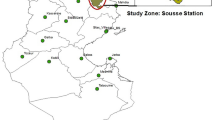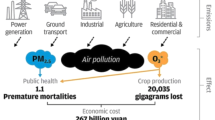Abstract
Satisfying the national air quality standards represents a challenge nowadays for developing countries. Air pollution in industrial cities is one of the foremost problems that affect human health and might cause loss of human life. One of the main attributes that can cause a significant impact on people’s health is the ground-level ozone pollution. Ozone can raise the ratio of asthma attacks, permanent damage to lungs, and maybe death. Forecasting its concentration levels is essential for planning well-designed environment protection strategies. In this paper, a state-space reservoir model called cycle reservoir with jumps (CRJ) is used to predict the level of ozone concentrations in the east of Croatia utilizing some meteorological parameters including the temperature, relative humidity, wind speed, wind direction, and the pollutants PM10. CRJ is a particular type of recurrent neural networks with powerful performance when applied for complex temporal problems. Two cases from the east of Croatia are investigated in this work: the Kopaćki Rit area and the Osijek city. The proposed CRJ model shows superiority of CRJ model in forecasting ozone concentrations compared to linear regression, multilayer perceptron (MLP) and radial basis function (RBF) network.









Similar content being viewed by others
References
Abdul-Wahab S, Al-Alawi S (2002) Assessment and prediction of tropospheric ozone concentration levels using artificial neural networks. Environ Modell Softw 17:219–228
Agency EP (2014) Air pollution: current and future challenges
Al-Alawi SM, Abdul-Wahab SA, Bakheit CS (2008) Combining principal component regression and artificial neural networks for more accurate predictions of ground-level ozone. Environ Modell Softw 23:396–403
Alkasassbeh M, Sheta AF, Faris H, Turabieh H (2013) Prediction of PM10 and TSP air pollution parameters using artificial neural network autoregressive, external input models: a case study in salt, Jordan. Middle-East J Sci Res 14:999–1009
Banan N, Latif MT, Juneng L, Khan MF (2014) An application of artificial neural networks for the prediction of surface ozone concentrations in Malaysia. In: From Sources to Solution, Springer, pp 7–12
Bandyopadhyay G, Chattopadhyay S (2007) Single hidden layer artificial neural network models versus multiple linear regression model in forecasting the time series of total ozone. Int J Environ Sci Technol 4:141–149
Belwal C, Sandu A, Constantinescu EM (2004) Adaptive resolution modeling of regional air quality. In: Proceedings of the 2004 ACM Symposium on Applied Computing, SAC ’04. ACM, New York, pp 235–239
Biancofiore F, Verdecchia M, Carlo PD, Tomassetti B, Aruffo E, Busilacchio M, Bianco S, Tommaso SD, Colangeli C (2015) Analysis of surface ozone using a recurrent neural network. Sci Total Environ 514:379–387
Chattopadhyay S (2007) Prediction of mean monthly total ozone time series–application of radial basis function network. Int J Remote Sens 28:4037–4046
Chen H, Tiňo P, Rodan A, Yao X (2014) Learning in the model space for cognitive fault diagnosis. IEEE Trans Neural Netw Learn Syst 25:124–136
Coman A, Ionescu A, Candau Y (2008) Hourly ozone prediction for a 24-h horizon using neural networks. Environ Modell Softw 23:1407–1421
Dan J, Guo W, Shi W, Fang B, Zhang T (2014) Deterministic echo state networks based stock price forecasting. In: Abstract and Applied Analysis, Hindawi Publishing Corporation, vol 2014
Faris H, Alkasassbeh M, Rodan A (2014) Artificial neural networks for surface ozone prediction: models and analysis. Polish Journal of Environmental Studies 23(2)
Feng Y, Zhang W, Sun D, Zhang L (2011) Ozone concentration forecast method based on genetic algorithm optimized back propagation neural networks and support vector machine data classification. Atmos Environ 45:1979–1985
Fitzpatrick J, Cunningham R, Davidson J, Poots E (2010) Air pollution: action in a changing climate. Technical report http://www.defra.gov.uk
Ghaly A (2012) Mapping environmental pollution, contamination, and waste in the United States. In: Proceedings of the 3rd International Conference on Computing for Geospatial Research and Applications. ACM, p 41
Gómez P, Nebot A, Ribeiro S, Alquézar R, Mugica F, Wotawa F (2003) Local maximum ozone concentration prediction using soft computing methodologies. Syst Anal Modell Simul 43:1011–1031
Gorai A, Mitra G (2017) A comparative study of the feed forward back propagation (ffbp) and layer recurrent (lr) neural network model for forecasting ground level ozone concentration. Air Qual Atmos Health 10:213–223
Ha QP, Wahid H, Duc H, Azzi M (2015) Enhanced radial basis function neural networks for ozone level estimation. Neurocomputing 155:62–70
Hájek P, Olej V (2012) Ozone prediction on the basis of neural networks, support vector regression and methods with uncertainty. Ecol Inform 12:31–42
Hassoun M (1995) Fundamentals of Artificial Neural Networks. MIT Press, Cambridge
Hornik KJ, Stinchcombe D, White H (1989) Multilayer feedforward networks are universal approximators. Neural Netw 2:359–366
Inal F (2010) Artificial neural network prediction of tropospheric ozone concentrations in Istanbul, Turkey. Clean–Soil Air Water 38:897–908
Jaeger H (2001) The “echo state” approach to analysing and training recurrent neural networks - with an erratum note
Kheirbek I, Wheeler K, Walters S, Pezeshki G, Kass D (2009) Air pollution and the health of new yorkers: the impact of fine particles and ozone. Technical report. New York City Department of Health and Mental Hygiene, East Lansing, Michigan
Kisi O, Parmar KS, Soni K, Demir V (2017) Modeling of air pollutants using least square support vector regression, multivariate adaptive regression spline, and m5 model tree models. Air Qual Atmos Health 10:873–883
Kovač-Andrić E, Radanović T, Topalović I, Marković B, Sakač N (2013) Temporal variations in concentrations of ozone, nitrogen dioxide, and carbon monoxide at osijek, Croatia. Advances in Meteorology
Kovač-Andrić E, Sheta A, Faris H, Gajdošik MŠ (2016) Forecasting ozone concentrations in the east of Croatia using non-parametric neural network models. J Earth Syst Sci 125:997–1006
Kumar N, Middey A, Rao PS (2017) Prediction and examination of seasonal variation of ozone with meteorological parameter through artificial neural network at Neeri, Nagpur, India. Urban Clim 20:148–167
Liu Z, Liu A, Wang C, Niu Z (2004) Evolving neural network using real coded genetic algorithm (GA) for multispectral image classification. Fut Gener Comput Syst 20:1119–1129
Luna A, Paredes M, de Oliveira G, Corrêa S (2014) Prediction of ozone concentration in tropospheric levels using artificial neural networks and support vector machine at Rio de Janeiro, Brazil. Atmos Environ 98:98–104
Mak MW, Cho KW (1998) Genetic evolution of radial basis function centers for pattern classification. In: 1998. IEEE World Congress on Computational Intelligence. The 1998 IEEE International Joint Conference on Neural Networks Proceedings, vol 1. IEEE, pp 669–673
Marco G, Bo X (2013) Air quality legislation and standards in the european union: background, status and public participation. Adv Clim Chang Res 4:50–59
Nunnari G, Cannavó F (2007) A new cost function for air quality modeling. J VLSI Signal Process Syst 49:281–290
Peng H, Lima AR, Teakles A, Jin J, Cannon AJ, Hsieh WW (2017) Evaluating hourly air quality forecasting in Canada with nonlinear updatable machine learning methods. Air Quality. Atmos Health 10:195–211
Radko K, Pavel Š (2015) The orediction of tropospheric ozone using a radial basis function network. Springer International Publishing, Cham, pp 115–123
Rodan A, Tiňo P (2012) Simple deterministically constructed cycle reservoirs with regular jumps. Neural Computation, MIT Press, Cambridge
Rodan A, Faris H (2016) Credit risk evaluation using cycle reservoir neural networks with support vector machines readout. Springer, Berlin, pp 595–604
Salcedo-Sanz S, Camacho J, Pérez-Bellido ÁM, Ortíz-García EG, Portilla-Figueras A, Hernandez-Martin E (2011) Improving the prediction of average total ozone in column over the Iberian peninsula using neural networks banks. Neurocomputing 74:1492–1496
Selvaraj RS, Elampari K, Gayathri R, Jeyakumar SJ (2010) A neural network model for short term prediction of surface ozone at tropical city. Int J Eng Sci Technol 2:5306–5312
Sexton RS, Dorsey RE, Johnson JD (1999) Optimization of neural networks: a comparative analysis of the genetic algorithm and simulated annealing. Eur J Oper Res 114:589–601
Sheta A, Ghatasheh N, Faris H (2015) Forecasting global carbon dioxide emission using auto-regressive with exogenous input and evolutionary product unit neural network models. In: The 6th International Conference on Information and Communication Systems (ICICS), pp 182–187
Sheta AF, Faris H (2015) Influence of nitrogen-di-oxide, temperature and relative humidity on surface ozone modeling process using multigene symbolic regression genetic programming. Int J Adv Comput Sci Appl (IJACSA) 6:270–275
Solaiman T, Coulibaly P, Kanaroglou P (2008) Ground-level ozone forecasting using data-driven methods. Air Qual Atmos Health 1:179–193
Sousa S, Martins F, Alvim-Ferraz M, Pereira MC (2007) Multiple linear regression and artificial neural networks based on principal components to predict ozone concentrations. Environ Modell Softw 22:97–103
Tsai Ch, Chang Lc, Chiang Hc (2009) Forecasting of ozone episode days by cost-sensitive neural network methods. Sci Total Environ 407:2124–2135
Tsakiri KG, Zurbenko IG (2011) Prediction of ozone concentrations using atmospheric variables. Air Quality. Atmos Health 4:111–120
Vakil-Baghmisheh MT, Pavešić N (2004) Training RBF networks with selective backpropagation. Neurocomputing 62:39–64
Acknowledgements
The authors gratefully acknowledge the financial support given to the project by the Croatian Ministry of Science, Education and Sports. The authors also thank Meteorological and Hydrological Service of Croatia and the Ministry of Environmental and Nature Protection.
Funding
This research was funded by the Croatian Ministry of Science, Education and Sports.
Author information
Authors and Affiliations
Corresponding author
Ethics declarations
Conflict of interests
The authors declare they have no conflict of interest.
Rights and permissions
About this article
Cite this article
Sheta, A., Faris, H., Rodan, A. et al. Cycle reservoir with regular jumps for forecasting ozone concentrations: two real cases from the east of Croatia. Air Qual Atmos Health 11, 559–569 (2018). https://doi.org/10.1007/s11869-018-0561-9
Received:
Accepted:
Published:
Issue Date:
DOI: https://doi.org/10.1007/s11869-018-0561-9




